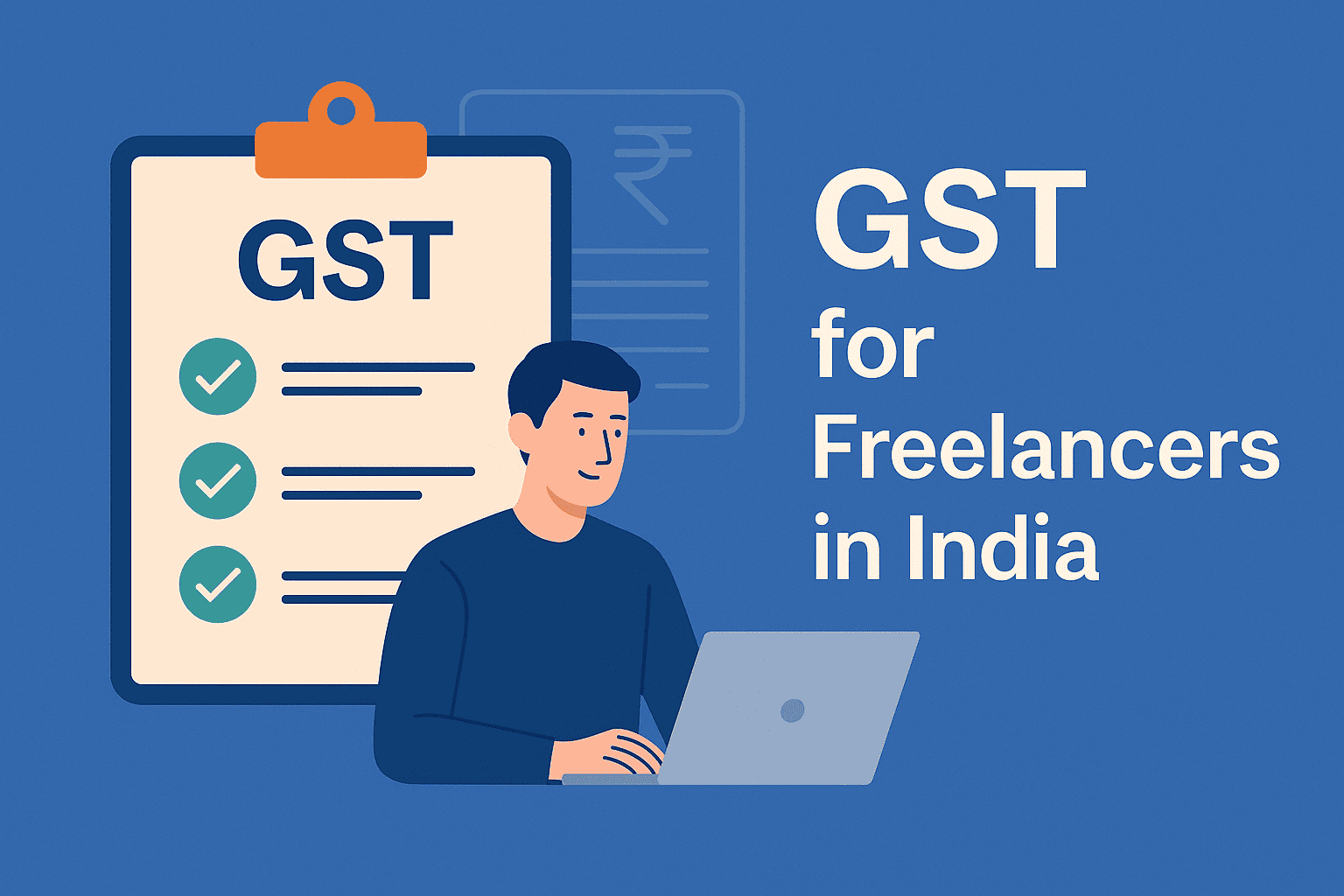Why GST Registration for Freelancers in India Matters
As India’s freelance economy accelerates, tax compliance becomes more important than ever. Whether you’re a designer, developer, content writer, or digital consultant, understanding the GST registration process for freelancers in India is essential in 2025.
Freelancers offering services for a fee may be liable under the Goods and Services Tax (GST) Act, and failing to comply can lead to penalties, missed business opportunities, and loss of credibility with clients.
Who Must Register for GST as a Freelancer?
As per the GST rules for Indian freelancers in 2025, registration is mandatory in the following cases:
- Annual income exceeds ₹20 lakhs (₹10 lakhs in special category states)
- Export of services: Even if your turnover is less than ₹20 lakhs, if you’re working with international clients, GST registration is compulsory
- Platform-based freelancers: Using services like Fiverr or Upwork often requires GSTIN for payment processing and tax compliance
Optional registration is available if you’re below the threshold, but it involves regular filing and compliance.
GST Threshold Limit for Freelancers (2025)
| Freelancer Type | GST Registration Required? |
|---|---|
| Turnover > ₹20 lakhs | Yes |
| Working with international clients | Yes |
| Earning via online freelance platforms | Usually Yes |
| Indian clients only, < ₹20 lakhs turnover | No (Optional) |
Documents Needed to Apply for GST as a Freelancer
Before you begin the registration, prepare the following documents:
- PAN card
- Aadhaar card
- Passport-size photo
- Business address proof (rent agreement, utility bill, etc.)
- Bank account details (cancelled cheque or bank statement)
- Business constitution proof (optional for individuals)
- Digital Signature Certificate (required for companies or LLPs)
How to Apply for GST as a Freelancer: Step-by-Step Guide
Step 1: Visit the Official GST Portal
Access https://www.gst.gov.in
Step 2: Start New Registration
Go to Services > Registration > New Registration. Choose “Taxpayer,” then enter your name, PAN, mobile number, and email.
Step 3: Get TRN via OTP
You will receive OTPs on your mobile and email. Once verified, you will get a Temporary Reference Number (TRN).
Step 4: Fill Part B of the Form
Use your TRN to log in and complete the rest of the form. Upload documents and enter your professional and banking details.
Step 5: Submit Application
Use EVC or DSC to digitally submit your GST application.
Step 6: Await Officer Verification
Your application will be reviewed. If all is accurate, approval usually comes within 7–10 working days.
Step 7: Receive GSTIN
Once approved, your GSTIN (Goods and Services Tax Identification Number) will be issued. You can download your registration certificate from the portal.
What Happens After You Register?
After receiving your GSTIN, freelancers are required to:
- Issue GST-compliant invoices mentioning tax breakdown and GSTIN
- File GST returns monthly or quarterly depending on turnover (via QRMP scheme if eligible)
- Pay GST dues before due dates
- Maintain proper records of transactions, invoices, and returns for auditing
GST Filing for Freelancers in 2025
Filing GST returns is a critical part of ongoing compliance:
- GSTR-1: Monthly or quarterly return of outward supplies
- GSTR-3B: Monthly self-declaration return with tax payment
- Annual Return: Mandatory if turnover crosses ₹2 crores
Tip: Use a GST software or hire a CA to avoid penalties and delays.
Real-Life Examples for Clarity
Example 1: Kritika – Graphic Designer
Kritika earns ₹22 lakhs annually and works with clients from the US and Singapore. She is registered under GST and uses the QRMP scheme for quarterly filing.
Example 2: Harsh – Freelance Writer
Harsh earns ₹8 lakhs and works only with Indian clients. GST registration is optional for him, so he has chosen to remain unregistered.
Frequently Asked Questions (FAQs)
1. Is GST registration compulsory for freelancers in India?
Yes, if your turnover exceeds ₹20 lakhs or you provide services to clients outside India.
2. Can freelancers below ₹20 lakhs turnover register for GST?
Yes, voluntary registration is allowed but requires consistent filing and tax compliance.
3. Do I need a GSTIN to work on platforms like Upwork or Fiverr?
In most cases, yes. These platforms may require a GSTIN for payments or GST deduction compliance.
4. Can I claim Input Tax Credit as a freelancer?
Yes, if registered under GST and filing returns correctly, you can claim ITC on business expenses.
5. What is the penalty for non-registration?
The penalty can be 10% of the tax due, or ₹10,000 minimum. In fraud cases, it may go up to 100%.
Whether you’re a rising content creator, consultant, or full-time freelancer, GST registration for freelancers in India is no longer optional if you are growing or working globally. It enhances your credibility, enables input tax credits, and ensures long-term tax compliance.
To avoid future complications, consult a GST practitioner and get your documents in order today. For freelancers eyeing scale in 2025, registering under GST is a smart and essential move.
Also Read: Zero Tax for Startups in India: A Defining Move to Fuel Innovation and Entrepreneurship

1 thought on “Ultimate 2025 Guide to GST Registration for Freelancers in India”